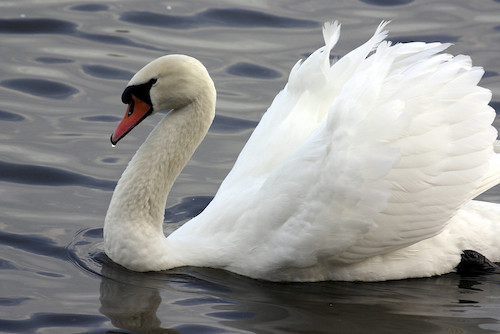 Watch for graceful Mute Swans on The Lizard. The creeks of the Helford River are a good place to look.
Watch for graceful Mute Swans on The Lizard. The creeks of the Helford River are a good place to look.
Photo: © Allan Drewitt/Natural England
Scientific name: Cygnus olor
Cornish name: Alargh
 Britain’s largest bird is also one the best-loved: the Mute Swan, a familiar large white waterbird with its graceful S-shaped neck seen floating peacefully on shallow lakes or slow-moving water, in towns as much as in the countryside. Although Mute Swans do not breed on the moorlands of south-west Britain (or in northern Scotland or mid-Wales), they are found across the mainland and Ireland throughout the year. Overwintering birds bring numbers in the UK to almost 80,000, compared to between 6,000 and 7,000 breeding pairs through the summer.
Britain’s largest bird is also one the best-loved: the Mute Swan, a familiar large white waterbird with its graceful S-shaped neck seen floating peacefully on shallow lakes or slow-moving water, in towns as much as in the countryside. Although Mute Swans do not breed on the moorlands of south-west Britain (or in northern Scotland or mid-Wales), they are found across the mainland and Ireland throughout the year. Overwintering birds bring numbers in the UK to almost 80,000, compared to between 6,000 and 7,000 breeding pairs through the summer.
This is a bird of contrasts. Anyone who has strayed too near the territory of a male swan (called a cob) will know they aggressively defend their patch, first striking a threatening pose with their wings (all 2.4 m wingspan of them) held over their back, and then charging disturbingly fast over the water to chase the intruder away. But the bird is also perceived as an emblem of fidelity – pairs usually mate for life, and renew their bond through a courtship ‘dance’ each spring – and of nurture – most of us will have seen the female swan (known as a pen) on the water carrying her cygnets on her back when they are very young.
Mute Swans make large nests of vegetation at the water’s edge or on small islands: they often repair and use the same nest from year to year, with both male and female protecting the young once hatched. The clutch size is four to seven eggs, but mortality is high for young cygnets at up to 50%, mainly as a result of predation by animals such as crows, foxes and mink. Cygnets stay with their parents for about six months, before flying away and joining a flock until they reach breeding maturity at four years old.
Swan numbers are generally thought to be increasing in the UK following the ban on the use of lead weights in fishing, reversing the decline in population seen a few decades ago. In England, of course, all unmarked Mute Swans on open water belong to the crown: the exception is the large colony of wild swans at Abbotsbury, which were excluded from the 1482 Act of the Swan. This Act permitted landowners to mark swans as theirs by making notches in their mandible (for possible consumption in those days, not for conservation purposes!). The swans were marked annually in an event known as ‘upping’: today swan ‘upping’ is still carried out on certain stretches of the Thames, but the rather cruel practice of notching the mandible is no longer used, and the birds are instead given leg rings.
The video below, made by the Avibirds team and used with their permission, has lots of further useful information about Mute Swans.
Did you know…?
…Not so mute? The name ’Swan’ is an Old English word meaning, somewhat ironically for this species given its full name, ‘singer’. Mute Swans do in fact have some basic vocalisations, including a hissing noise from an adult defending territory or quiet squeaks from cygnets. It is thought however that the derivation of the word ‘swan’ refers to the impressive sound of their wing beats (referred to by the poet W.B. Yeats as ‘the bell-beat of their wings above my head’).
…If you notice a swan with orange marking on its head, this is caused by iron residues on the river or lake bed staining its feathers as the bird looks for its food of aquatic vegetation and insects.
More information and references:
Gooders, J. and Harris, A., 1986. Field Guide to the Birds of Britain and Ireland. Kingfisher Books, London.
Published: January 2014
Author: Amanda Scott
Photo: © Allan Drewitt/Natural England
